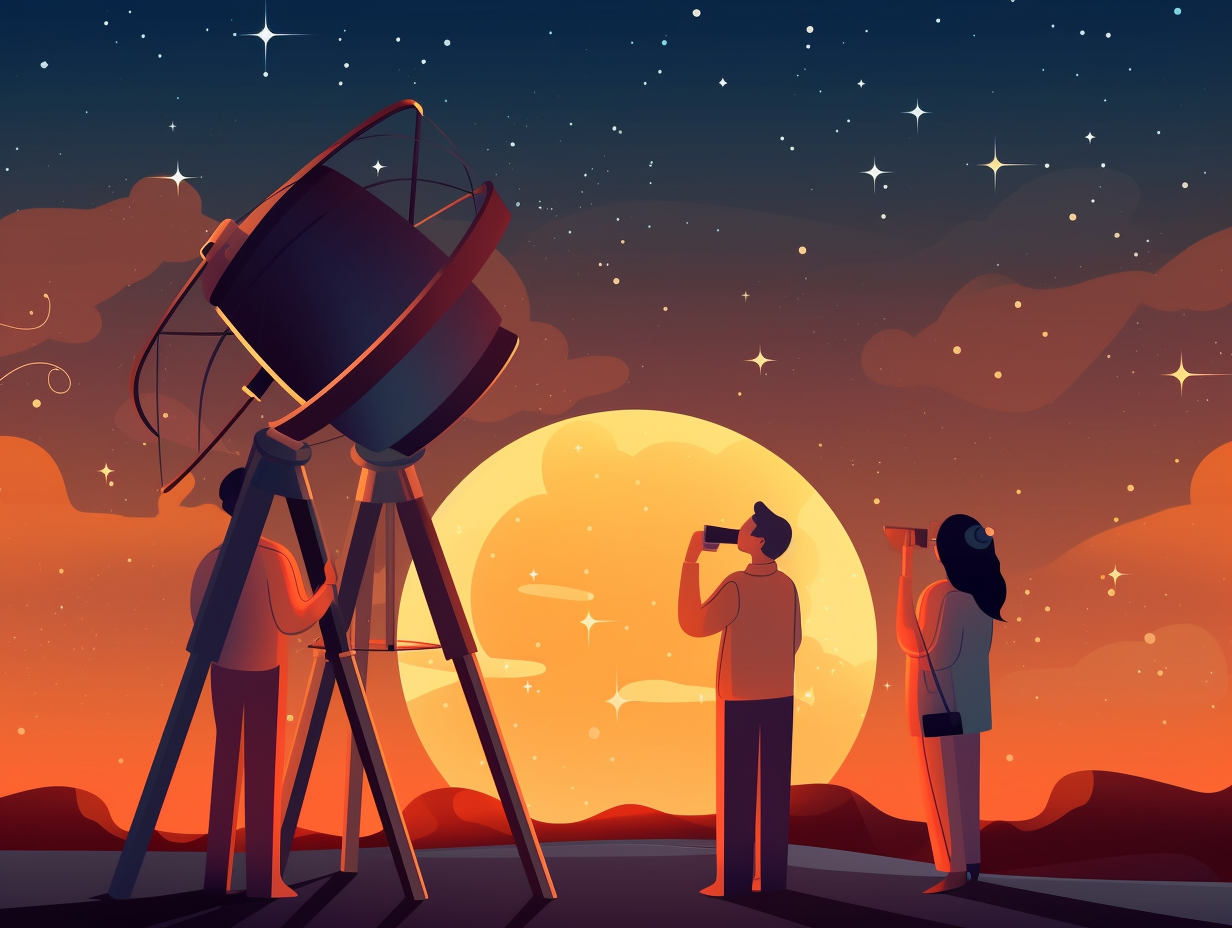15 Dazzling Fun Facts About Shooting Stars You Never Knew Before

1. Misleading Starry Entrances
Stars, they're just like us: they love a dramatic entrance! But don't be fooled by their flashy performance as shooting stars: they're actually meteors burning up in Earth's atmosphere due to friction and heat, traveling at phenomenal speeds of up to 200,000 kilometers per hour.
Source => study.com
2. Meteor Speedsters
Faster than the Millennium Falcon on a starry night, swifter than the Flash on his way to save the day, shooting stars zip through the sky like astronomical athletes – but wait, there's more: These sizzling speedsters are actually meteoroids traveling up to 71 kilometers per second, only to combust into a brilliant light show when colliding with our atmosphere, creating cosmic spectacles that delight star-gazers everywhere!
Source => nationalgeographic.org

Did you know that Halley's Comet is essentially a cosmic snow cone? Discover the fascinating mix of ices and dust that make up this celestial phenomenon!
=> Fun Facts about Comets
3. Meteorite Gold Rush
If you're looking to shoot for the stars and cash in on the cosmic lottery, consider meteorite hunting as your next gold rush: Some meteorites, like the celestial Sikhote-Alin that made its grand entrance in Russia in 1947, command a staggering price tag of over $1,000 per gram due to its unique shape and precious cargo of iron and nickel – but be warned, interstellar treasure hunting may require some earthly permissions from landowners or governmental space guardians to keep it all legal and above (or below) board.
Source => mrnussbaum.com
4. Comet Glitter Bomb Parties
When comets throw a raging space party, they leave behind some unforgettable confetti: Earth casually passes through this celestial litter, transforming the scattered debris into a sensational display of shimmering shooting stars. Talk about "glitter bomb" on a cosmic scale! The serious reveal: Meteor showers result from our planet traversing through comet debris, and as the rocky particles strike Earth's atmosphere, they generate enchanting streaks of light that can amount to thousands of brilliant meteors per hour.
Source => nationalgeographic.org

5. Colorful Cosmic Runway
Before you start wishing upon that "star" like Geppetto did for Pinocchio, let's burst your cosmic bubble: Shooting stars are actually meteors - small rock or iron fragments blazing through Earth's atmosphere, creating those lovely streaks of light. Comets shedding dust or asteroid collisions are the gossip factories spreading these shiny rocks, and it's their chemical compositions that give them a colorful personality – from iron-induced yellow, to a calcium-driven purple, or even a nickel-meets-oxygen green party. Yet, no matter their hue, these meteoric fashion statements make the night sky a runway worth gazing at.
Source => nationalgeographic.org
6. Meteor Shower Season Spectacles
It's raining stars, hallelujah! Or rather, it's meteor shower season, and the sky is putting on a spectacular show outshining even the most famous shooting stars: Meteor showers, like the Geminids and Perseids, occur when Earth passes through debris left behind by comets or asteroids, resulting in a dazzling spectacle of hundreds, sometimes thousands, of shooting stars streaking across the sky in the same general direction, making skywatchers go starry-eyed every year.
Source => space.com
7. Crazy Bolide Explosions
When the sky explodes with a bright streak and makes a bang like Thor partying too hard in Asgard: that's when a shooting star goes bolide-mode. That's right, these colossal firecrackers in the sky are called superbolides, and they pack such a punch that they can explode with the force of 500 kilotons of TNT, cause earthquakes, and potentially wreak havoc, like the Chelyabinsk meteor in Russia in 2013.
Source => nationalgeographic.org
8. Star-struck Misconceptions
Whoever named them "shooting stars" must have been star-struck by their celestial beauty: these dazzling flashes of light are actually meteoroids colliding with Earth's atmosphere with various sizes, compositions, and speeds that can create meteors of different colors. Oh, and sometimes they make it to Earth's surface as meteorites – talk about making a grand entrance!
Source => britannica.com
9. Flaming Cosmic Text Messages
Who needs smoke signals when you have fireballs lighting up the sky? Imagine getting a giant, flaming text message from the cosmos: Surprise, it's just a rare and magnificent shooting star! These brilliant celestial couriers not only send a jaw-dropping message but may also leave behind wispy smoke trails or trains, which can last for several minutes. Most often, though, these burning, sky-faring vagabonds dazzle us for mere seconds before they're reduced to cosmic dust by Earth's mighty atmosphere.
Source => amsmeteors.org

10. Earth's Celestial Vacuum Cleaner
Think of shooting stars as Earth's celestial vacuum cleaner, sucking up 48.5 tons of space debris daily with their incandescent tails: our planet encounters roughly 44,000 kilograms of meteoritic material coming its way daily, creating those fantastic streaks of light we love to wish upon. Marvel at the meteoric maestros known as "fireballs" as they outshine Venus and belt out their cosmic tunes, audible up to 30 miles away! Be it regularly scheduled meteor showers or the unexpected starry solos, just remember to keep your eyes peeled and your wishes ready, as they make their mesmerizing performances in the great cosmic theatre above.
Source => space.com
11. Attention-seeking Celestial Posers
Shooting stars: the cosmic outcasts crashing Earth's party with a fiery bang, or just celestial posers doing their best to sparkle as they burn up in our atmosphere? Serious reveal: In reality, they're meteoroids – small chunks of space debris – blazing their way through Earth's atmosphere, often confused with satellites like Starlink which reflect sunlight, cause light pollution, and, truth be told, annoy astronomers and stargazers alike with their attention-seeking flares.
Source => en.wikipedia.org
12. Overheated Asteroids
Ever wondered why asteroids break up into shooting stars? It's because they just can't handle the heat! But seriously, folks: The famed Geminid meteor shower happens each December when Earth passes through debris from asteroid 3200 Phaethon, which has an orbit bringing it closer to the Sun than Mercury, causing intense temperature swings and consequently, ejecting space debris that results in up to 120 shooting stars per hour at the shower's zenith.
Source => thehindu.com
13. Chelyabinsk Meteorite's Grand Entrance
Talk about a smashing entrance: The 2013 Chelyabinsk Meteorite not only shattered windows and injured over 1,000 people, but also burst onto the scientific scene with a boom equivalent to 500 kilotons of TNT, as the celestial celebrity event featured the rare and ancient LL5 chondrite - a primitive material straight from the birth of our solar system.
Source => rockseeker.com
14. Secret Mermaid Crushes
As shooting stars swan dive through our atmosphere to satisfy their secret mermaid crushes, they leave Earthlings with a sense of cosmic wonder and myriads of unfulfilled wishes: The surprising truth is that of the 500 meteoroids that grace our skies annually, a measly 10 or less ever make it to the Earth's surface, usually descending into remote areas or the ocean's embrace.
Source => psi.edu

15. Wishing on Flaming Space Rocks
Ready for some cosmic irony? When you wish upon a shooting star, you're actually hoping that a flaming rock from outer space will deliver your dreams: Turns out, shooting stars are just meteoroids - fragments of comets or asteroids - that burn up while entering Earth's atmosphere. By studying their composition and movement, scientists unlock secrets about the origins of our solar system and the evolution of celestial bodies. So, while they won't grant your wishes, they do hold the key to unraveling a universe of knowledge!
Source => amnh.org
Related Fun Facts




















